In this article, I’ll be sharing essential tips and techniques on different ways to preserve food with 4 methods of food preservation techniques and 4 bonus methods.
Throughout this article, we’ll delve into the details of four key food preservation methods: chilling, freezing, sugaring, and canning.
We’ll explore their processes, advantages, and any necessary precautions to keep in mind.
We will cover four additional bonus methods as well.
By the end, you’ll have a comprehensive understanding of how to effectively preserve food and make the most of your culinary endeavors.
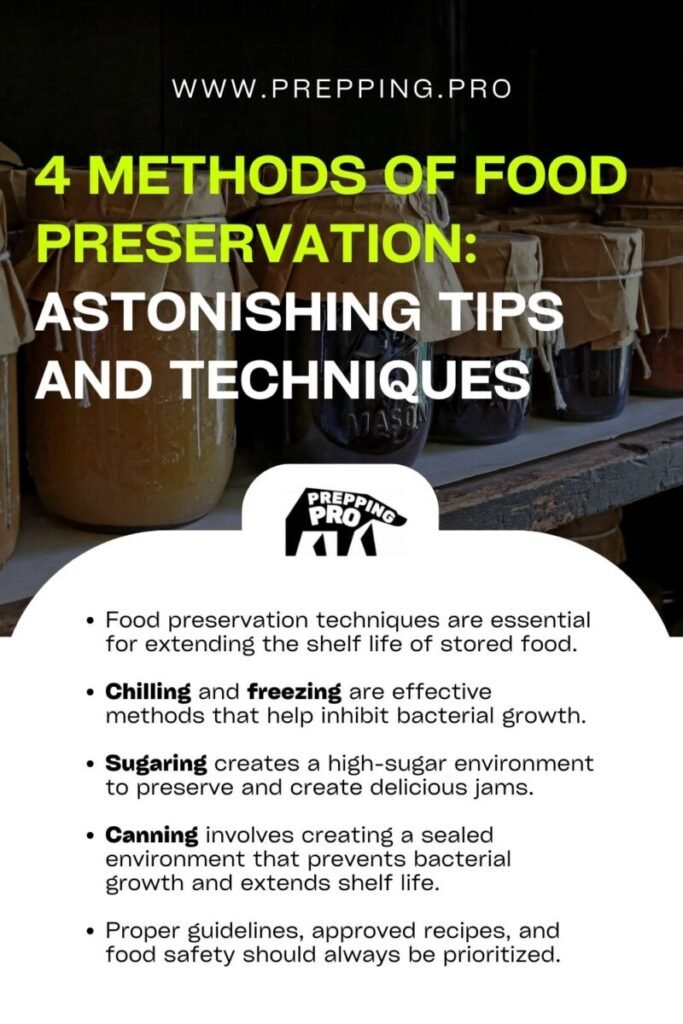
Key Takeaways:
- Food preservation techniques are essential for extending the shelf life of stored food.
- Chilling and freezing are simple and effective methods that help inhibit bacterial growth.
- Sugaring creates a high-sugar environment to preserve fruits and create delicious jams.
- Canning involves creating a sealed environment that prevents bacterial growth and extends shelf life.
- Proper guidelines, approved recipes, and food safety should always be prioritized when preserving food.
When it comes to food storage methods, there are a variety of options available.
From chilling and freezing to canning and sugaring, each technique has its own unique benefits and considerations.
It’s crucial to understand the proper guidelines and prioritize food safety to ensure that the preserved food remains safe to consume.
Table of Contents
Our Experience
Let’s dive into the world of food preservation, shall we?
It’s like a survival skill for us urban preppers and, let’s be honest, a sanity saver for us busy parents.
No more panic at meal times, because, voila, we’ve got a stash of preserved goodies!
Chilling and Freezing: Our fridge and freezer are lifesavers. Keep the fridge cool and the freezer colder. Easy way to keep food fresh longer.
Sugaring: Sweet deal for making jams and marmalades. It’s like bottling up summer flavors for those cold days.
Canning: Jar up those tasty fruits and veggies. It’s all about keeping those goodies safe and sound in their glass homes.
Salting: Dry out those meats with some salt. Simple, effective, but watch the salt intake!
Drying: Slice, dry, snack. Perfect for herbs, fruits, and DIY snack time.
Fermentation: Get funky with sauerkraut and yogurt. It’s healthy, tangy, and surprisingly fun.
Smoking and Curing: Flavor town! Smoke and cure meats for that delicious, long-lasting goodness.
There you go, quick and easy. Preserving food? It’s like a little kitchen adventure with tasty rewards!
And remember, every jar you seal is like a little high-five to future you.
Okay lets dive into the details now.
Chilling
Chilling is a simple yet effective method of food preservation.
Hack: Freeze a sponge soaked in water and put it in a Ziploc bag. It’s a DIY ice pack that keeps your fridge cooler and absorbs excess moisture.
Storing food at a low temperature in the refrigerator slows bacterial growth and minimizes spoilage.
To safely refrigerate food, it is important to set the fridge temperature between 1°C and 4°C and store raw and ready-to-eat food separately.
Labeling food with best before and use by dates, avoiding overloading the fridge, and using a FIFO food storage system can help maintain food quality and minimize waste.
Refrigeration plays a crucial role in keeping our food fresh and safe.
By maintaining the ideal temperature, harmful bacteria that cause foodborne illnesses can be inhibited, ensuring the longevity of perishable items. It is recommended to have separate refrigerators for raw and cooked food to prevent cross-contamination.
The use of food labeling with clear dates allows us to keep track of the freshness and safety of stored food, enabling us to consume them before they expire.
Implementing a FIFO (First-In, First-Out) food storage system is beneficial in minimizing food waste.
By organizing our refrigerated items and placing the ones with the earliest expiration dates in front, we ensure that perishable food items are consumed before they spoil.
This system helps us avoid the accumulation of forgotten or expired food items at the back of the refrigerator, reducing unnecessary waste.
Benefits of Chilling:
- Slows bacterial growth
- Minimizes food spoilage
- Helps maintain food quality
- Reduces waste
| Refrigeration Tips | Notes |
|---|---|
| Set the fridge temperature between 1°C and 4°C | Optimal temperature for slowing bacterial growth |
| Store raw and ready-to-eat food separately | Prevents cross-contamination |
| Label food with best before and use by dates | Helps keep track of freshness and safety |
| Avoid overloading the fridge | Allows for proper air circulation |
| Use a FIFO food storage system | Minimizes waste by consuming items in order |
Freezing

Freezing is a popular method of preserving food for long-term storage.
Hack: Here’s a neat idea – use an ice cube tray to freeze fresh herbs in olive oil. You’ll get perfect little flavor cubes for cooking!
When food is properly frozen, it can remain safe to eat for extended periods of time.
To ensure the best results, it is important to maintain the freezer temperature between -18°C and -22°C. This low temperature inhibits bacterial growth and helps to preserve the quality of the food.
When freezing food, it is crucial to use airtight containers or freezer bags to prevent freezer burn.
Freezer burn occurs when the food is exposed to air, causing dehydration and affecting the texture and taste.
By properly sealing the food, you can maintain its freshness and extend its shelf life.
It is also important to freeze the food before its best before or use by date. Freezing does not reverse the spoilage process, but it does slow it down significantly.
By freezing food at its peak freshness, you ensure that it retains its quality when thawed.
When it comes time to use the frozen food, defrost it safely in the refrigerator or using the defrost setting on the microwave.
Avoid defrosting at room temperature, as this can promote bacterial growth.
Benefits of Freezing:
- Preserves the nutritional value of food
- Allows for long-term storage
- Minimizes food waste by extending shelf life
Factors to Consider:
- Maintain the freezer temperature between -18°C and -22°C
- Use airtight containers or freezer bags to prevent freezer burn
- Freeze food before its best before or use by date
- Thaw food safely in the refrigerator or using the defrost setting on the microwave
By following these guidelines, you can effectively freeze food and enjoy its freshness and quality even after extended periods of storage.
Sugaring
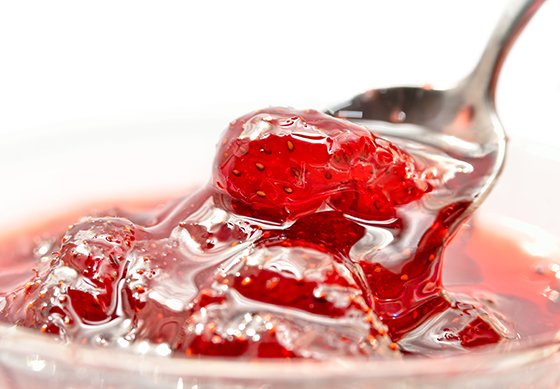
When it comes to preserving food, sugar can be a magical ingredient.
Hack: Got overripe fruit? Mash it up, mix with sugar, and freeze in small portions. You’ve got yourself an instant dessert topping or sweetener for later use.
Sugaring is a traditional method that has been used for centuries to preserve fruits and other foods.
By reducing the water content in food, sugar creates a high-sugar environment that inhibits bacterial growth and helps extend the shelf life of the preserved items.
One of the most popular applications of sugaring is in the creation of jams, marmalades, and preserved fruits.
These sweet treats not only provide a burst of flavor but also allow us to enjoy the taste of ripe fruits long after their season has passed.
The process of sugaring involves cooking fruits with sugar, which helps draw out the moisture and create a thick, sweet preserve. Different recipes and techniques can be used to achieve various textures and flavors.
It is important to note that while sugaring is a great way to preserve food, it is essential to be mindful of the health risks associated with excessive sugar consumption.
Consuming too much sugar can have negative effects on our health, including an increased risk of obesity, diabetes, and heart disease.
Therefore, it is important to enjoy sugared preserves in moderation as part of a balanced diet.
Sugaring Recipes: A Delightful Journey for Your Palate
Exploring sugaring recipes can be a delightful journey for your palate.
From classic strawberry jam to exotic mango chutney, there are countless recipes available that allow you to experiment with different fruits, flavors, and textures.
Here are a few popular sugaring recipes to inspire your culinary adventures:
| Recipe | Ingredients |
|---|---|
| Strawberry Jam | Strawberries, sugar, lemon juice |
| Peach Preserves | Peaches, sugar, vanilla extract |
| Orange Marmalade | Oranges, sugar, lemon juice |
| Spiced Apple Butter | Apples, sugar, cinnamon, nutmeg |
Whether you spread them on toast, use them as a filling for pastries, or enjoy them straight from the jar, sugared preserves are a delightful way to savor the flavors of the season all year round.
Salting
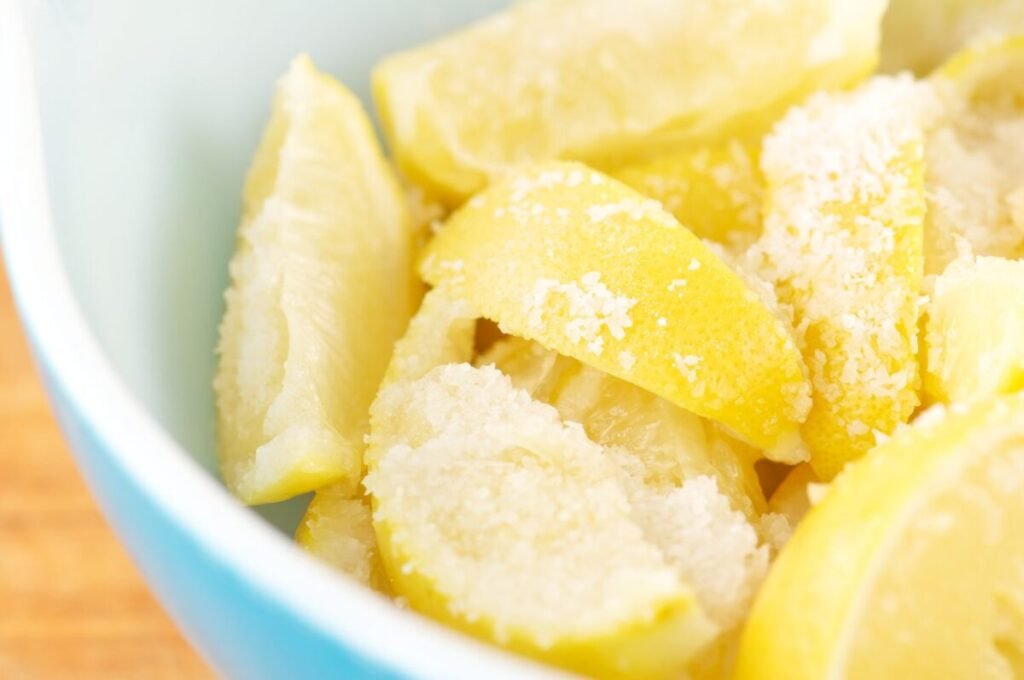
When it comes to preserving food, salting is a time-tested method that has been used for centuries.
Hack: For an extra flavor kick, salt your meat and layer it with onions in a container. It’s a double whammy of preservation and taste infusion.
Salting involves the use of salt to draw out moisture from food and create an inhospitable environment for bacteria, thus preventing spoilage.
This method is particularly popular for preserving meats, such as bacon, ham, and fish. In addition to inhibiting bacterial growth, salting also enhances the flavor and texture of the preserved food.
There are two common techniques for salting food: dry curing and wet curing.
Dry curing involves rubbing or sprinkling salt directly onto the food, while wet curing entails submerging the food in a brine solution.
Both methods work effectively to preserve food, but the choice depends on the type of food being preserved and personal preference.
It is important to note that while salting can be a great way to extend the shelf life of food, excessive salt consumption can have negative health effects.
High sodium intake has been linked to increased blood pressure and other cardiovascular issues.
Therefore, it is crucial to practice moderation and balance when incorporating salt-preserved foods into your diet.
Table: Comparison of Dry Curing and Wet Curing
| Technique | Dry Curing | Wet Curing |
|---|---|---|
| Method | Salt is applied directly to the food | Food is submerged in a saltwater brine |
| Time | Can take several days or weeks | Requires less time compared to dry curing |
| Flavor | Intense and concentrated flavor | Milder flavor, with a hint of saltiness |
| Texture | Dense and firm texture | Tender and more moist texture |
Whether you choose to dry cure or wet cure, salting provides a wonderful way to preserve food while enhancing its taste.
Just remember to enjoy salt-preserved foods in moderation and be mindful of your overall sodium intake for the sake of your health.
Canning

Canning is a popular method of preserving food in sealed jars to extend its shelf life.
Hack: Put a rubber band around your jar before tightening the lid. It gives extra grip, making opening those jars a breeze later on.
This technique involves removing oxygen, creating a specific environment, and sealing the jars to prevent bacterial growth and spoilage.
It is essential to follow a safe canning process and use approved recipes to ensure the quality and safety of preserved food.
The canning process typically involves two methods: boiling water bath canning and steam pressure canning.
Boiling water bath canning is suitable for high-acid foods such as fruits, pickles, jams, and jellies.
It involves submerging the filled jars in boiling water for a specific period, which creates a high enough temperature to kill bacteria and create a vacuum seal.
Steam pressure canning, on the other hand, is necessary for low-acid foods such as vegetables, meat, and seafood.
This method uses a pressure canner to reach a higher temperature, eliminating the risk of botulism.
Safe Canning Tips and Guidelines
- Use appropriate canning jars, lids, and bands that are specifically designed for canning.
- Inspect jars for any cracks, chips, or defects that may compromise the seal.
- Follow approved canning recipes from trusted sources to ensure the correct ratios of ingredients and processing times.
- Ensure proper sterilization of jars, lids, and utensils before use.
- Adhere to recommended processing times and temperatures to eliminate bacteria effectively.
- Allow jars to cool naturally and check the seals before storing. A proper seal should be concave and firm when pressed.
Canning is a versatile preservation method that allows you to enjoy the flavors of seasonal produce all year round.
By following safe canning practices and using approved recipes, you can confidently preserve a variety of foods in jars, ensuring their quality and safety for long-term storage.
Drying
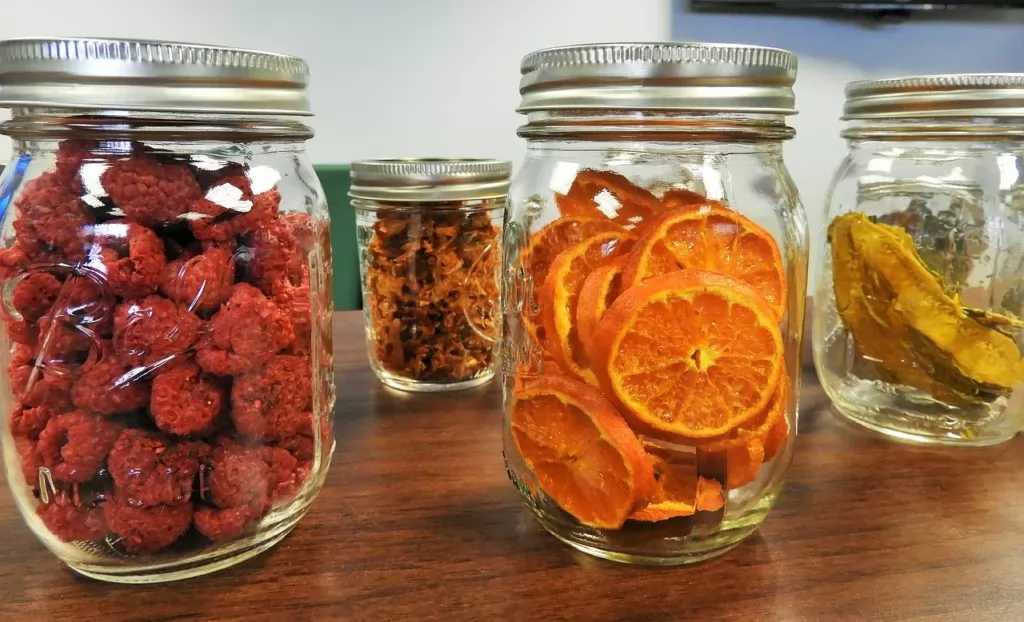
Drying is a widely used method of food preservation that involves removing moisture from food, thereby inhibiting the growth of bacteria and other microorganisms.
Hack: No dehydrator? No problem! Use your car as a solar dehydrator on a sunny day. Just place herbs on a tray and leave them on the dashboard – it’s eco-friendly and cost-free.
There are various techniques and equipment available for drying food, each offering its own advantages and considerations.
Air Drying
Air drying is a simple and cost-effective method that relies on natural airflow to remove moisture from food. It is commonly used for herbs, fruits, and vegetables.
To air dry food, it is important to spread the items out in a single layer on a clean surface, preferably in a well-ventilated area.
Sun Drying
Sun drying is a traditional method that utilizes the heat and energy from the sun to remove moisture from food.
It is suitable for hot and dry climates and is often used for fruits, vegetables, and meats.
To sun dry food, it is crucial to protect it from insects, dust, and other contaminants by using screens or coverings.
Dehydrating Equipment
Dehydrating equipment, such as food dehydrators, provides a controlled environment for drying food.
These appliances use low heat and a built-in fan to circulate air and remove moisture. Dehydrators offer precise temperature and time settings, making them ideal for efficiently drying a variety of food items.
| Method | Advantages | Considerations |
|---|---|---|
| Air Drying | Low cost, no additional equipment required | Slower process, vulnerability to pests and weather conditions |
| Sun Drying | Natural and energy-free, suitable for hot climates | Dependent on weather conditions, longer drying times |
| Dehydrating Equipment | Controlled environment, precise drying settings | Initial cost of equipment, limited capacity |
Whether using air drying, sun drying, or dehydrating equipment, it is important to ensure that the food is properly dried to prevent spoilage.
Properly dried food should be leathery or crisp, depending on the item, and should not feel sticky or have any moisture present.
Drying food not only extends its shelf life but also concentrates the flavors, making it a convenient and tasty option for snacking, cooking, and emergency food supplies.
By using suitable drying techniques and equipment, individuals can enjoy the benefits of preserved food that is lightweight, portable, and easy to store.
Next, we will explore the method of fermentation, another intriguing way to preserve food. Stay tuned!
Fermentation
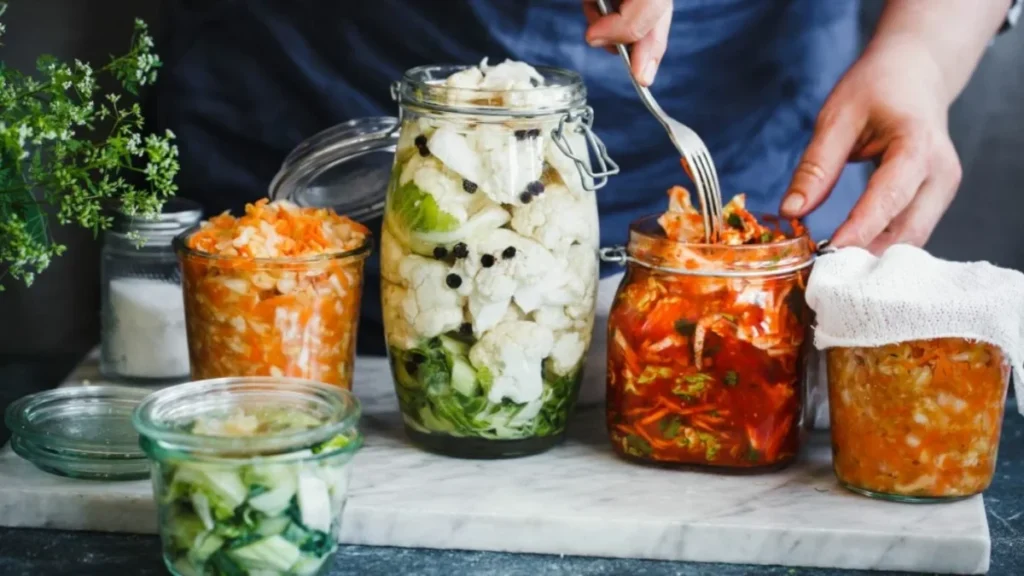
Fermentation is a fascinating process that has been used for centuries to preserve and transform food.
Hack: Get crafty with a plastic water bottle as a makeshift airlock for fermenting. It allows gases to escape while keeping air out, perfect for small batches.
It involves the breakdown of carbohydrates and proteins in food by microorganisms, resulting in the production of acids, alcohol, or gases.
This not only extends the shelf life of the food but also enhances its flavor and nutritional value.
One of the most popular examples of fermented foods is sauerkraut, which is made by fermenting cabbage.
The process involves lactic acid bacteria breaking down the natural sugars in the cabbage, resulting in a tangy and slightly sour flavor.
Fermented foods like sauerkraut are not only delicious but also provide probiotics, which are beneficial for gut health.
Another well-known fermented food is yogurt, which is made by fermenting milk with live bacteria cultures.
The fermentation process converts lactose, the naturally occurring sugar in milk, into lactic acid. This gives yogurt its tangy flavor and creamy texture.
Yogurt is not only a tasty snack but also a good source of protein, calcium, and probiotics.
The Fermentation Process:
- The first step in the fermentation process is creating the right environment for the beneficial microorganisms to thrive. This often involves providing the food with a suitable temperature, pH level, and oxygen or anaerobic conditions.
- Once the conditions are set, the microorganisms, such as bacteria or yeasts, are added to the food. They consume the carbohydrates and proteins present and release various compounds such as acids, alcohols, or gases.
- Over time, the food undergoes a transformation, developing new flavors, textures, and aromas. The fermentation process can take anywhere from a few hours to several weeks, depending on the type of food and desired outcome.
- After fermentation is complete, the food is often refrigerated or stored in a cool place to slow down the activity of the microorganisms. This helps maintain the flavor and stability of the fermented food.
Fermentation is a versatile preservation method that can be used with a variety of foods, including vegetables, fruits, dairy products, and even beverages like wine and beer.
It not only extends the shelf life of food but also adds unique flavors and enhances nutritional value.
Exploring the world of fermented foods can open up a whole new range of culinary experiences.
| Fermented Food | Microorganisms Involved | Flavor Profile |
|---|---|---|
| Sauerkraut | Lactic acid bacteria | Tangy and slightly sour |
| Yogurt | Lactic acid bacteria | Tangy and creamy |
| Kimchi | Lactic acid bacteria, yeasts | Spicy and tangy |
| Kombucha | Acetic acid bacteria, yeasts | Tangy and effervescent |
By embracing the art of fermentation, we can not only preserve food but also unlock a world of unique flavors and textures.
Smoking and Curing
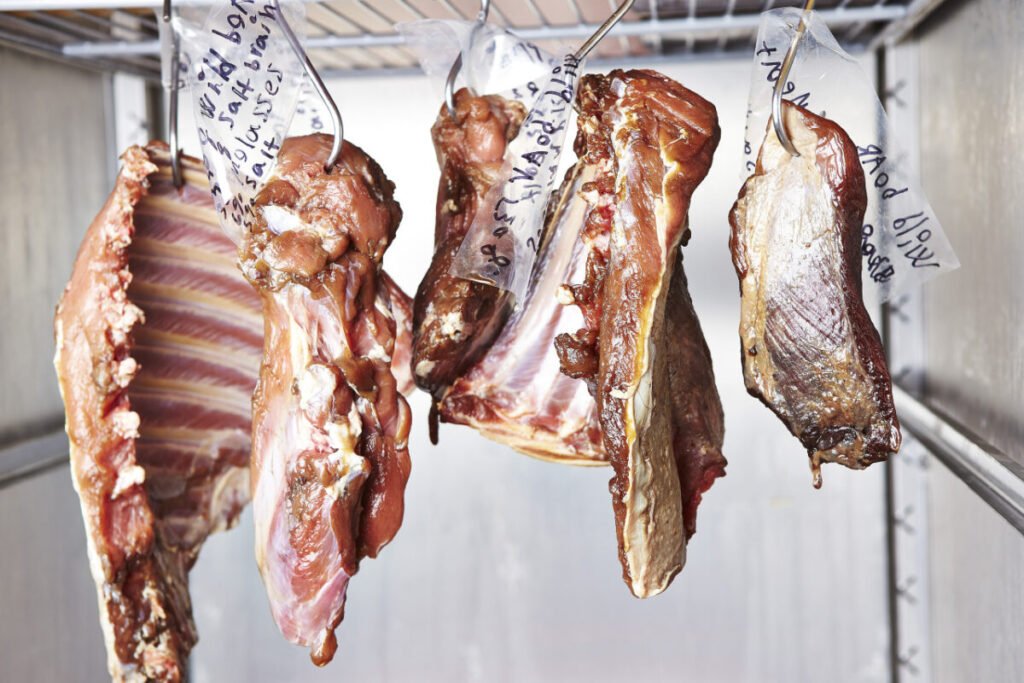
When it comes to preserving food, two popular methods are smoking and curing.
Hack: Want to add a unique twist to your smoked foods? Throw a pinch of tea leaves into your smoking chips for an aromatic surprise.
These techniques not only help extend the shelf life of various foods but also add unique flavors and textures.
Let’s take a closer look at smoking and curing and how they can be used in food preservation.
Smoking
Smoking involves exposing food to smoke, typically from burning wood chips or sawdust.
This process imparts a distinct smoky flavor and aroma to the food, enhancing its taste.
Smoked foods are particularly popular for meats such as bacon, ham, sausage, and fish like salmon.
To smoke food, it is essential to use the right types of wood depending on the desired flavor.
Common woods used for smoking include hickory, mesquite, apple, and cherry. Additionally, the temperature and duration of smoking play a crucial role in achieving the desired results.
Curing
Curing is a preservation method that involves the use of curing salts or nitrates to inhibit bacterial growth and prolong the shelf life of food.
It is commonly used for preserving meats like bacon, ham, and sausage.
Curing salts, such as Prague powder or pink curing salt, contain a precise mixture of salt and sodium nitrite, which helps prevent the growth of pathogens and gives the meat its characteristic pink color.
The curing process typically involves rubbing the meat with a curing mixture and allowing it to rest in a controlled environment for a specific period, allowing the flavors to develop.
| Method | Flavor | Commonly Used For |
|---|---|---|
| Smoking | Distinct smoky flavor | Meat (bacon, ham, sausage) and fish |
| Curing | Enhanced taste and prolonged shelf life | Meat (bacon, ham, sausage) |
Both smoking and curing offer unique ways to preserve and enhance the flavor of various foods.
Whether you’re a fan of smoky meats or enjoy the cured goodness of bacon, these methods provide a delicious and long-lasting way to enjoy your favorite foods.
Conclusion
Food preservation is essential for ensuring the safety, quality, and longevity of stored food.
By utilizing various preservation methods such as chilling, freezing, canning, and others, you can effectively extend the shelf life of food and reduce waste.
It is important to follow proper guidelines, use approved recipes, and prioritize food safety to make the most of food preservation techniques.
FAQ
What are some common food preservation methods?
Common food preservation methods include chilling, freezing, canning, drying, fermentation, smoking, and curing.
How does chilling help preserve food?
Chilling food in the refrigerator slows bacterial growth and minimizes spoilage. It is important to set the fridge temperature between 1°C and 4°C and store raw and ready-to-eat food separately to ensure safe refrigeration.
How long can frozen food remain safe to eat?
When stored properly at a freezer temperature between -18°C and -22°C, frozen food can remain safe to eat for extended periods of time.
What is sugaring and how does it preserve food?
Sugaring is a method of preserving food, particularly fruits, by reducing the water content and creating a high-sugar environment that inhibits bacterial growth. It is commonly used to make jams, marmalades, and preserved fruits.
What is salting and how does it preserve food?
Salting is a preservation method that involves drawing water out of food and inhibiting bacterial growth. Dry curing and wet curing are two common forms of salting.
How does canning preserve food?
Canning is a method of preserving food in sealed jars to extend its shelf life. The process involves creating an acidic, sugary, or salty environment and sealing the jars to prevent bacterial growth.
How does drying preserve food?
Drying is a method of preserving food by removing moisture. This can be done through air drying, sun drying, or using dehydrating equipment.
What is fermentation and how does it preserve food?
Fermentation is a preservation method that involves the breakdown of carbohydrates and proteins in food by microorganisms, resulting in the production of acids, alcohol, or gases. This process not only preserves food but also enhances its flavor and nutritional value.
How does smoking and curing preserve food?
Smoking and curing involve exposing food to smoke and using curing salts or nitrates to inhibit bacterial growth. Smoking adds flavor to the food while curing prolongs its shelf life.
What are some other methods of food preservation?
Other methods of food preservation include dehydration, freezing, emergency food rotation, and traditional food preservation methods such as pickling and fermenting.


